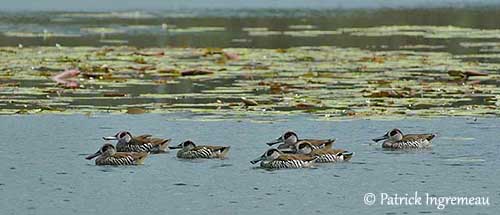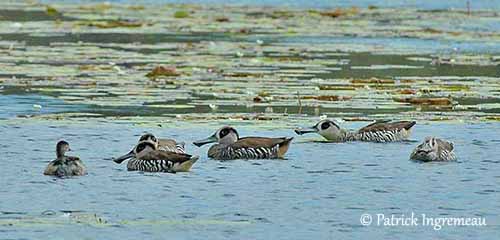
Fr: Canard à oreilles roses
Ang: Pink-eared Duck - Zebra Duck - Zebra Teal
All: Rosenohrente
Esp: Pato Pachón
Ita: Anatra zebrata australiana
Nd: Lepelbekeend
Sd: Zebraand
Photographers:
Patrick Ingremeau
TAMANDUA
Alan & Ann Tate
AA Bird Photography
Text by Nicole Bouglouan
Sources:
HANDBOOK OF THE BIRDS OF THE WORLD vol 1 by Josep del Hoyo-Andrew Elliot-Jordi Sargatal - Lynx Edicions - ISBN: 8487334105
GUIDE DES CANARDS, DES OIES ET DES CYGNES – de Steve Madge - Delachaux et Niestlé - ISBN: 2603013769
Wikipedia, the free encyclopaedia
Norfolk Wildfow - Roger Cattermole
Pink-eared Duck
Malacorhynchus membranaceus
Anseriformes Order – Anatidae Family
INTRODUCTION:
The Pink-eared Duck is the nearest relative of the Scarlett’s Duck (Malacorhynchus scarletti) that became extinct in New Zealand following Polynesian arrival.
It is endemic to Australia, and only vagrant in New Zealand. Its peculiar large, spatulate bill makes it unmistakable. Although having enigmatic relationships, this duck is most closely related to shelducks (Tadorninae) than dabbling ducks (Anatinae).
The Pink-eared Duck is the only member of the genus Malacorhynchus, and the only one in the order Anseriformes with carotenoid pigments in its feathers, involving the typical pink “ear” spot giving this species its name.
The odd-shaped bill plays an important role in the feeding behaviour of this duck by filtering the water to retain only the food items. The Pink-eared Duck is also known as Zebra Duck and Zebra Teal due to the striking black-and-white barred pattern of the underparts. It is widespread and locally abundant in its range.

DESCRIPTION OF THE BIRD:
Biometrics:
Length: 36-45 cm
Wingspan: 57-70 cm
Weight: M: 290-480 g – F: 272-423 g
The Pink-eared Duck adult is a small duck with large bill and strongly barred underparts. The upperparts including mantle, back and wings are brown with narrow paler vermiculations. The rump is white and the uppertail-coverts are dark brown, whereas the short tail is brown with narrow white terminal band. The upperwing shows narrow, white trailing edge.
The white underparts are strongly barred brown from upperbreast to vent, with broader and darker pattern on flanks. The undertail-coverts are pale chestnut. The underwing is white with brown flight-feathers and pale barring on underwing-coverts.
On the head, forehead and crown are grey but the face is white. There is a conspicuous dark brown eye-patch, extending as narrow stripe to the nape, and larger stripe to the hindneck. We can see a small pink patch above and behind the eye. Foreneck, neck and head sides are white and narrowly barred grey.
The massive, oddly-shaped bill is grey, with a laterally protruding membrane of skin at the tip of the upper mandible, similar to soft membranous flaps. The eyes are dark brown. Legs and webbed feet are dark grey.
The female resembles male but she is smaller and slightly paler.
The juvenile is duller and browner than adults, with less conspicuous barring and greyer forehead. The pink “ear” spot is very indistinct.
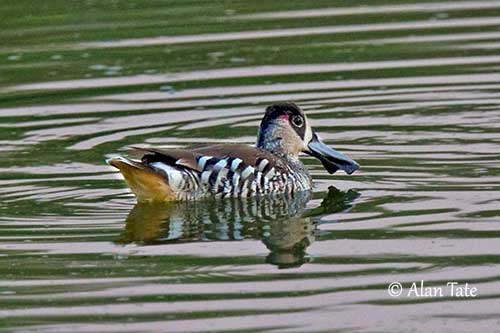
RANGE:
The Pink-eared Duck is endemic to Australia where it is widespread except for the driest regions of W and S Australia. The main populations occur in SW and SE Australia.
This species is nomadic and can be seen irregularly through Australia, but outside the coastal regions, its presence is closely related to temporary wet areas.
HABITAT:
The Pink-eared Duck frequents inland wetlands, shallow lakes and ponds, stagnant water with rich aquatic life (including sewage ponds), often saline and brackish waters of inland continent. It usually avoids the fast-moving, clear or deep waters, and the coastal wetlands with high rainfall. Large flocks can be seen in extensive open wetlands.
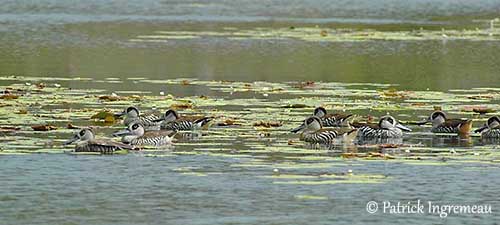
CALLS AND SONGS: SOUNDS BY XENO-CANTO
The Pink-eared Duck male gives repeated chirrup while in flight or on water. The sounds are described as trilling, chirrups or twittering. We can hear high-pitched “ee-jik” or “tu-ick” and a low, nasal “grunk”.
During pair formation, the bill-tossing display is accompanied by “whee-ooo” or “weeee-you” or “who-ee-oo” calls. The female’s voice is lower.
In defence behaviour, it utters a loud, trumpeted whistle “whee-ooo” and this call is probably given by both sexes.
BEHAVIOUR IN THE WILD:
The Pink-eared Duck feeds mostly on a variety of planktonic organisms such as crustaceans, molluscs and various insects. It also consumes plant-matter including algae and microscopic seeds.
It feeds by dabbling in shallow water, submerging the bill but also head and neck to reach preys on the bottom. It rarely performs upending.
The large flat bill is used to filter microscopic plants and animals, thanks to the fine lamellae that retain only the food items. It is often seen in pairs or in groups, and these groups perform communal feeding by swimming head-to-tail in vortexing motion, each bird benefiting from the disturbed preys as they rotate.
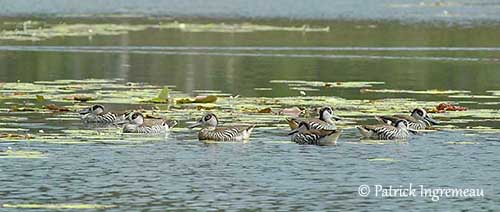
The Pink-eared Duck is monogamous with long-term pair-bonds, something unusual in Anatidae. Pair formation involves typical displays including head-tossing while calling loudly.
They can breed at any time of the year, depending on water levels. They nest close to the water and sometimes, a pair may eject another bird species in order to use its nest. The pair builds its own nest on the eggs of the chased bird. Several females can lay in the same nest, and 50-60 eggs can be seen together. The male takes part in some nesting duties but it does not incubate.
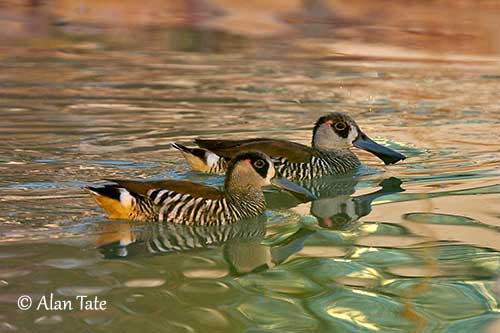
They are often seen perched out of the water, on branches or logs, and they spend little time on the ground.
The Pink-eared Duck is nomadic and sometimes dispersive, with movements related to water levels.
It flies with rapid wingbeats. The flushed groups circle wetlands and land very quickly.
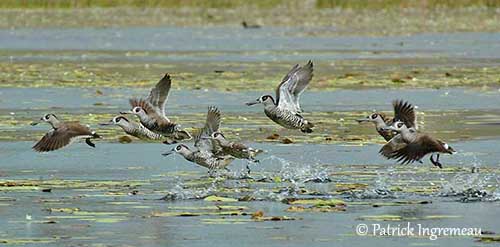
REPRODUCTION OF THIS SPECIES:
Breeding can occur all year round depending on flood waters. In SE Australia, the Pink-eared Duck breeds usually between August and February, after the winter rains.
It nests in single pairs or in loose groups. The nest is built in tree hollows, nest boxes and old nests of Fulicula and Gallinula species. It is a rounded mass of down placed in hollow or on stump above water, and generally close to the water.
The female lays 3-11 (usually 6-8) creamy-white eggs. She incubates alone during about 26 days. At hatching, the ducklings have pale grey-brown down above and whitish below. They have conspicuous dark brown eye patch and eye stripe, and the bill is similar to that of adults, with the membranous flaps. The chicks are tended by both parents and can be seen swimming with them while searching for food. They fledge between 45 and 60 days after hatching.
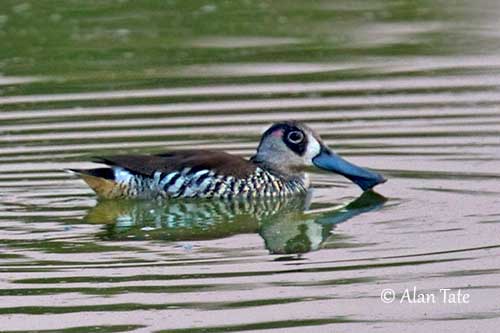
PROTECTION / THREATS / STATUS:
The Pink-eared Duck is widespread and locally abundant and hunting occurs only across parts of the range.
The population is not quantified, but there are probably several hundred thousand. But the nomadic character of this species does not allow better estimate. There are probably more than 1,000,000 individuals in the global range.
The Pink-eared Duck is currently evaluated as Least Concern.
